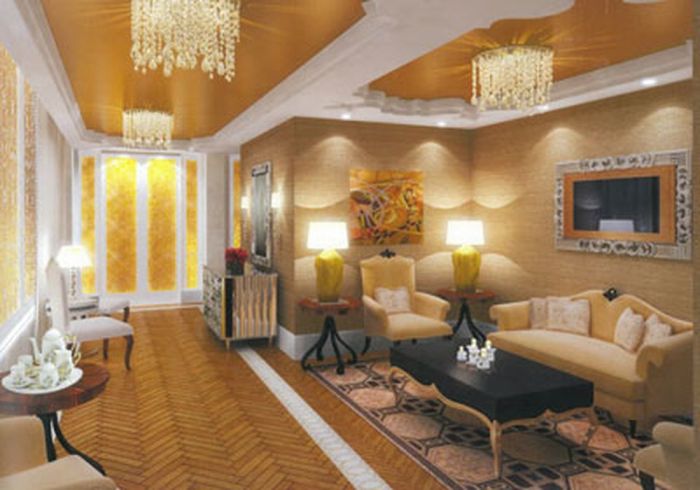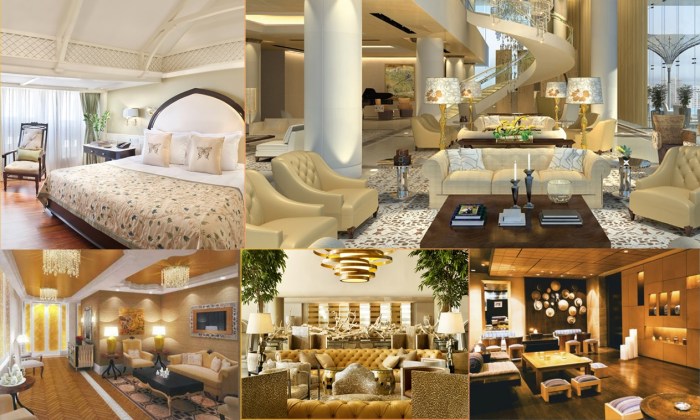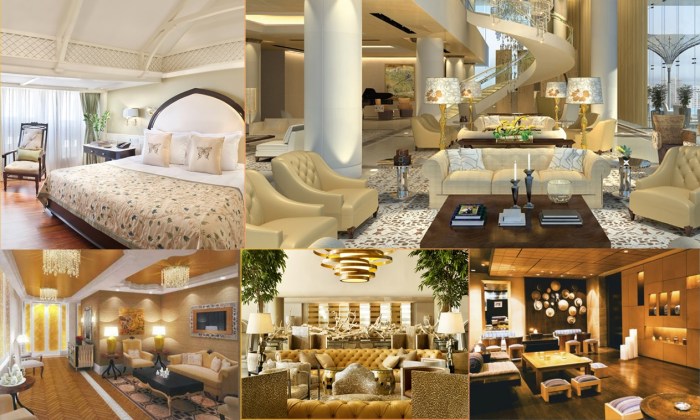Ambani House interior design is a testament to opulence and architectural brilliance, showcasing a harmonious blend of modern aesthetics and traditional Indian elements. The residence, owned by India’s richest man, Mukesh Ambani, is a marvel of engineering and design, reflecting a lifestyle of unparalleled luxury.
From the intricate details of the hand-crafted furniture to the breathtaking art installations, every aspect of the interior design exudes elegance and sophistication. The house is a testament to the Ambani family’s taste and appreciation for the finer things in life, with each space meticulously curated to create a sense of grandeur and comfort.
The Ambani Residence: A Global Icon

The Ambani Residence, also known as Antilia, is a 27-story skyscraper in Mumbai, India, owned by Mukesh Ambani, the chairman and managing director of Reliance Industries. It is a testament to the country’s economic growth and the opulent lifestyle of its elite.
The residence’s design is a blend of modern architecture and traditional Indian elements, making it a unique and recognizable landmark.
Architectural Style and Significance
The architectural style of Antilia is a fusion of modern and traditional elements. The building features a distinctive vertical design, with a series of setbacks and terraces that create a sense of verticality. The facade is clad in glass and steel, giving it a sleek and modern appearance.
The building’s interiors, however, incorporate traditional Indian elements, such as intricate carvings, marble floors, and traditional Indian furniture. This blend of styles reflects the Ambani family’s desire to create a home that is both modern and rooted in their cultural heritage.The significance of the Ambani Residence lies in its architectural innovation and its role as a symbol of India’s economic power.
It is one of the tallest residential buildings in the world and is a testament to the country’s growing architectural ambitions. The residence has also been praised for its sustainability features, such as its solar panels and rainwater harvesting system.
Prominent Features of the Exterior Design
The exterior design of Antilia is characterized by its verticality, its use of glass and steel, and its incorporation of traditional Indian elements. The building’s facade is composed of a series of setbacks and terraces, which create a sense of verticality and break up the building’s mass.
The use of glass and steel gives the building a sleek and modern appearance, while the incorporation of traditional Indian elements, such as intricate carvings and stonework, adds a sense of cultural richness.The building’s exterior design has a significant impact on its overall aesthetic.
The verticality of the building creates a sense of grandeur and power, while the use of glass and steel gives it a modern and sophisticated look. The incorporation of traditional Indian elements adds a sense of cultural richness and heritage to the building.
Historical Context and Inspiration Behind the Design
The design of Antilia was inspired by the Ambani family’s desire to create a home that reflects their cultural heritage and their modern lifestyle. The building’s architects, Perkins+Will, were tasked with creating a building that was both innovative and culturally sensitive.
The architects drew inspiration from traditional Indian architecture, as well as from modern skyscrapers around the world.The historical context of the building is also important to understand its design. The Ambani family is one of the wealthiest families in India, and their residence is a symbol of their success.
The building’s design reflects the country’s economic growth and its growing architectural ambitions.
Luxury Living
The interior design of the Ambani residence is a testament to their opulent lifestyle and discerning taste. It embodies a blend of modern aesthetics and traditional Indian elements, creating a harmonious and luxurious living environment. The choice of materials reflects a commitment to quality, craftsmanship, and sustainability.
Materials and Design Philosophy, Ambani house interior design
The design philosophy behind the Ambani residence is characterized by a fusion of modern and traditional elements, resulting in a unique and luxurious aesthetic. The materials used throughout the house are carefully selected for their quality, durability, and aesthetic appeal.
- Natural Stone:Marble, granite, and sandstone are extensively used in the interiors, adding a touch of elegance and sophistication. The natural patterns and textures of these materials create a sense of grandeur and timeless beauty.
- Wood:Rich mahogany, teak, and rosewood are used for furniture, flooring, and paneling, adding warmth and sophistication to the interiors. The intricate carvings and polished finishes showcase the craftsmanship and artistry involved in creating these pieces.
- Glass:Large windows and glass walls provide ample natural light and offer stunning views of the city. The use of glass also adds a sense of spaciousness and modernity to the interiors.
- Metals:Silver, gold, and bronze accents are incorporated throughout the house, adding a touch of glamour and sophistication. These metals are often used in decorative elements, furniture, and lighting fixtures.
Key Interior Spaces
The Ambani residence is spread across 27 floors and features numerous luxurious living spaces, each designed with a unique purpose and aesthetic.
- Grand Entrance Hall:The entrance hall is a grand and welcoming space that sets the tone for the rest of the house. It features a high ceiling, intricate marble flooring, and a stunning chandelier, creating a sense of awe and grandeur.
- Living Rooms:The living rooms are designed for comfort and entertainment, with plush sofas, armchairs, and coffee tables. The use of warm colors, soft lighting, and elegant furnishings creates a cozy and inviting atmosphere.
- Dining Room:The dining room is a formal space that can accommodate a large number of guests. It features a massive dining table, intricate chandeliers, and exquisite tableware, setting the stage for grand celebrations.
- Private Suites:Each of the private suites is a luxurious oasis, offering stunning views of the city and featuring state-of-the-art amenities. The suites are designed for comfort and privacy, with spacious bedrooms, luxurious bathrooms, and walk-in closets.
- Entertainment Spaces:The Ambani residence boasts a range of entertainment spaces, including a home theater, a multi-purpose hall, and a private temple. These spaces are equipped with cutting-edge technology and luxurious furnishings, providing a perfect setting for entertainment and relaxation.
Color Palettes, Textures, and Lighting
The color palettes, textures, and lighting used throughout the Ambani residence play a crucial role in creating a luxurious ambiance.
- Color Palettes:Neutral colors like white, cream, beige, and gray are used extensively in the interiors, creating a sense of spaciousness and elegance. These colors are often accented with pops of color, such as gold, silver, and deep blues, adding a touch of sophistication and vibrancy.
- Textures:The use of various textures adds depth and dimension to the interiors. Smooth marble floors contrast with the plush textures of the carpets and upholstery, creating a rich and tactile experience.
- Lighting:Natural light is maximized through large windows and skylights, while artificial lighting is carefully designed to create a warm and inviting atmosphere. Chandeliers, sconces, and recessed lighting are used to illuminate the interiors, adding a touch of glamour and sophistication.
A Symphony of Art and Design
The Ambani residence is not just a luxurious dwelling; it is a testament to the harmonious blend of art and design. Every corner of this architectural marvel is adorned with exquisite artwork, meticulously curated to enhance the overall aesthetic appeal and create an emotionally resonant environment.
The Integration of Art
The integration of art into the interior design is not merely decorative; it is a strategic approach to elevate the space and create a unique experience. The artwork seamlessly blends with the architectural elements, adding depth, texture, and visual interest to the surroundings.
The selection of art pieces reflects the Ambani family’s refined taste and appreciation for diverse artistic expressions.
Prominent Artworks and their Artistic Significance
The Ambani residence boasts a remarkable collection of artworks, each with its own story and artistic significance.
- Contemporary Sculptures:The residence features a collection of contemporary sculptures by renowned artists, adding a dynamic and modern touch to the interior. These sculptures often serve as focal points, drawing attention and sparking conversations.
- Abstract Paintings:Abstract paintings, characterized by their non-representational forms and vibrant colors, bring a sense of energy and movement to the spaces. These artworks evoke a sense of contemplation and inspire a unique emotional response.
- Traditional Indian Art:The Ambani family’s heritage is reflected in the inclusion of traditional Indian art forms. These artworks, ranging from intricate miniature paintings to vibrant murals, showcase the rich cultural heritage of India and add a touch of timeless elegance to the residence.
The Role of Art in Enhancing Aesthetic Appeal and Emotional Impact
Art plays a pivotal role in shaping the overall aesthetic appeal and emotional impact of the Ambani residence. The carefully curated collection of artworks creates a visually stimulating environment that engages the senses and sparks imagination. The art pieces also evoke a sense of tranquility, grandeur, and cultural richness, contributing to the overall ambiance of the home.
Sustainability and Eco-Friendly Design
The Ambani residence, a testament to luxury and grandeur, also embodies a commitment to sustainability and eco-friendly design principles. The design incorporates a range of sustainable practices and materials, showcasing a harmonious balance between opulence and environmental responsibility.
Sustainable Materials and Practices
The Ambani residence prioritizes the use of sustainable materials throughout its construction and interior design. These materials are chosen for their durability, low environmental impact, and ability to contribute to a healthier indoor environment.
- Locally Sourced Materials:The use of locally sourced materials minimizes transportation emissions and supports local economies. This includes using Indian marble, wood, and other natural resources, reducing the carbon footprint associated with material sourcing.
- Recycled and Upcycled Materials:The design incorporates recycled and upcycled materials, giving new life to discarded items. This includes using reclaimed wood for furniture and decorative elements, minimizing waste and promoting resource conservation.
- Energy-Efficient Building Materials:The residence utilizes energy-efficient building materials, such as high-performance glass that maximizes natural light while reducing heat gain. This reduces the reliance on artificial lighting and cooling systems, contributing to energy savings.
Eco-Friendly Design Elements
The Ambani residence showcases a variety of eco-friendly design elements that contribute to environmental responsibility. These elements demonstrate a conscious effort to minimize the building’s environmental impact while enhancing its sustainability.
- Green Roofs:The residence incorporates green roofs, which provide thermal insulation, reduce stormwater runoff, and create a habitat for local flora and fauna. These roofs contribute to a healthier environment and improve the building’s energy efficiency.
- Solar Panels:The residence features solar panels that generate renewable energy, reducing the reliance on fossil fuels and contributing to a cleaner energy grid. This demonstrates a commitment to sustainable energy practices and minimizes the building’s carbon footprint.
- Water Conservation Systems:The design incorporates water conservation systems, such as low-flow fixtures and rainwater harvesting, to minimize water consumption. These systems promote responsible water usage and reduce the strain on local water resources.
Energy Efficiency and Resource Conservation
The Ambani residence prioritizes energy efficiency and resource conservation through a combination of design strategies and technological advancements. These efforts aim to minimize the building’s environmental footprint and promote a sustainable lifestyle.
- Natural Ventilation and Lighting:The design maximizes natural ventilation and lighting, reducing the need for artificial heating, cooling, and lighting systems. This minimizes energy consumption and creates a more comfortable and healthy indoor environment.
- Smart Home Technology:The residence utilizes smart home technology to optimize energy usage and resource conservation. This includes automated lighting systems that adjust to natural light levels, temperature control systems that optimize energy consumption, and water-saving appliances.
- Waste Management Systems:The residence incorporates efficient waste management systems, including composting and recycling programs, to minimize waste generation and promote responsible disposal. This reduces the environmental impact of waste and promotes a circular economy.
A Glimpse into the Lifestyle

The Ambani residence is not just a home; it’s a testament to a lifestyle that seamlessly blends luxury, tradition, and modern technology. Every aspect of the design, from the grand architecture to the intricate details, reflects the family’s values and aspirations.
Unique Lifestyle Features and Amenities
The residence offers a range of amenities that cater to the diverse needs and interests of the Ambani family. Here’s a glimpse into some of the unique features:
| Feature | Description |
|---|---|
| Private Temple | A dedicated space for spiritual reflection and worship, showcasing intricate carvings and traditional architecture. |
| Multi-Level Garden | A sprawling green oasis with various themed gardens, offering a serene escape from the bustling city. |
| State-of-the-Art Cinema | A dedicated entertainment space with a high-tech cinema system for private screenings and family movie nights. |
| Health and Wellness Center | Equipped with advanced fitness facilities, a spa, and a swimming pool, ensuring a holistic approach to health and well-being. |
| Helipad | Provides convenient access for private travel, reflecting the family’s busy schedule and global connections. |
| Staff Quarters | Dedicated housing for the extensive staff, ensuring their comfort and convenience while serving the family. |
Impact on Daily Routines and Experiences
The design of the residence significantly impacts the daily routines and experiences of the residents. The open and interconnected spaces foster a sense of community and togetherness, while the dedicated areas provide privacy and individual retreat. The multi-level garden offers a serene escape from the bustling city, allowing for moments of relaxation and reflection.
The state-of-the-art cinema provides a luxurious entertainment experience for family gatherings and special occasions. The health and wellness center encourages a healthy lifestyle and promotes well-being for all residents.
Catering to the Ambani Family’s Needs and Preferences
The design of the Ambani residence reflects the family’s specific needs and preferences. The emphasis on tradition is evident in the private temple, while the modern amenities cater to their busy lifestyle and global connections. The spacious interiors provide ample room for family gatherings and celebrations, while the dedicated areas ensure privacy and individual space.The multi-level garden is a testament to the family’s love for nature, while the health and wellness center reflects their commitment to a healthy lifestyle.
The residence is a harmonious blend of tradition and modernity, reflecting the Ambani family’s unique identity and values.
The Ambani House
The Ambani residence, Antilia, is more than just a luxurious dwelling; it’s a powerful symbol of India’s economic ascent and its aspirations for the future. Its grand design and opulent features have become synonymous with the nation’s burgeoning wealth and its ambition to be recognized as a global power.
The Ambani House as a Symbol of Economic Growth
The sheer scale and extravagance of Antilia reflect India’s remarkable economic growth in recent decades. The country has witnessed a rapid transformation from a developing nation to a global economic powerhouse. The Ambani family, one of India’s wealthiest, has played a significant role in this economic boom through its Reliance Industries conglomerate.
Antilia serves as a visible testament to this success, showcasing the wealth generated through entrepreneurial spirit and business acumen.
- The house’s estimated cost of over $1 billion is a clear indicator of the vast wealth accumulated by India’s leading business families. This wealth, in turn, reflects the nation’s economic progress and its growing presence on the global stage.
- Antilia’s construction and design also demonstrate India’s burgeoning infrastructure capabilities and its ability to undertake ambitious projects. The complex engineering and architectural feats involved in building such a structure highlight the nation’s growing expertise and technological advancements.
- The house’s location in Mumbai, India’s financial capital, further emphasizes its connection to the nation’s economic dynamism and its aspirations for global dominance. It stands as a beacon of India’s economic prowess and its potential for further growth.
Final Thoughts: Ambani House Interior Design

The Ambani House stands as a symbol of India’s economic prowess and its burgeoning design landscape. It serves as a source of inspiration for architects and designers worldwide, showcasing the potential for merging traditional aesthetics with contemporary luxury. The house is a testament to the power of design to create not just a beautiful space, but also a lifestyle that reflects the aspirations and achievements of its occupants.
Commonly Asked Questions
What is the estimated cost of building the Ambani House?
The estimated cost of building the Ambani House is reported to be around $1 billion.
What is the total area of the Ambani House?
The Ambani House covers an area of approximately 400,000 square feet.
What are some of the unique features of the Ambani House?
Some of the unique features of the Ambani House include a three-story hanging garden, a nine-floor multi-level car park, a 168-room home, and a dedicated space for each member of the family.
Who designed the Ambani House?
The Ambani House was designed by the renowned architectural firm Perkins+Will.
Is the Ambani House open to the public?
The Ambani House is a private residence and is not open to the public.




